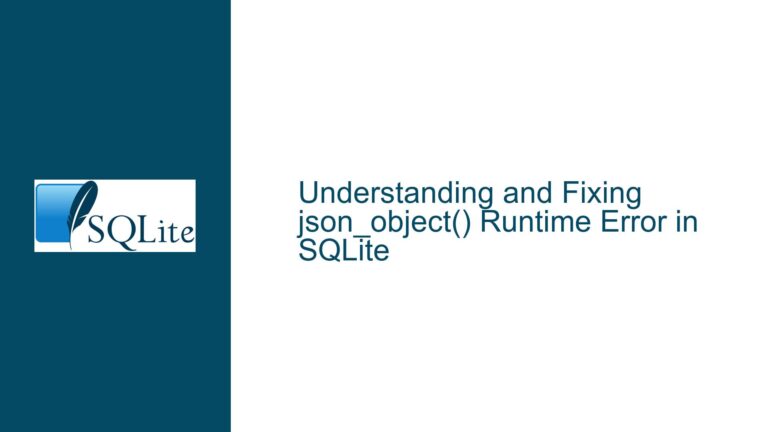Bulk Insert Speed Issue in SQLite3 OPFS with Worker Thread
Understanding the Bulk Insert Performance Bottleneck in SQLite3 OPFS
When working with SQLite3 in a web environment using the Origin Private File System (OPFS) and Web Workers, one of the most common performance bottlenecks encountered is the speed of bulk inserts. The issue arises when attempting to insert a large number of records, such as 10,000 rows, which can take an unexpectedly long time—up to 15 minutes in some cases. This performance degradation is particularly problematic when using Web Workers to handle database operations asynchronously, as the expected benefit of offloading work to a separate thread is negated by the slow insert speeds.
The core of the problem lies in the interaction between SQLite3, the OPFS, and the Web Worker architecture. SQLite3 is designed to be a lightweight, embedded database, but its performance can be significantly impacted by the way it interacts with the underlying file system and the JavaScript runtime. The OPFS, while providing a persistent storage solution for web applications, introduces additional overhead due to its asynchronous nature and the need to synchronize data between the main thread and the worker thread. Furthermore, the way SQL statements are executed in the worker thread can also contribute to the slowdown, especially when dealing with large datasets.
Exploring the Causes of Slow Bulk Inserts in SQLite3 OPFS
Several factors can contribute to the slow performance of bulk inserts in SQLite3 OPFS when using a Web Worker. One of the primary causes is the lack of transaction management in the insert operations. By default, each insert statement is treated as a separate transaction, which means that SQLite3 has to commit each insert individually. This results in significant overhead, as the database engine must write to the disk and update the journal file for each insert. In a high-latency environment like the OPFS, this overhead is exacerbated, leading to slower performance.
Another contributing factor is the way SQL statements are passed to the worker thread and executed. In the provided code, the ExecuteFunction is used to execute SQL statements sent via postMessage. This approach can introduce additional latency, as each SQL statement must be serialized, sent to the worker thread, deserialized, and then executed. When dealing with a large number of inserts, this process can become a bottleneck, especially if the SQL statements are not optimized or if the worker thread is not efficiently handling the incoming messages.
Additionally, the OPFS itself can introduce performance limitations. The OPFS is designed to provide a persistent storage solution for web applications, but it is not optimized for high-throughput, low-latency operations. The asynchronous nature of the OPFS means that each file operation, such as writing to the database file, incurs additional overhead. This overhead can be particularly noticeable when performing bulk inserts, as the database engine must wait for the file system to complete each write operation before proceeding to the next insert.
Optimizing Bulk Insert Performance in SQLite3 OPFS with Web Workers
To address the slow performance of bulk inserts in SQLite3 OPFS, several optimization strategies can be employed. The first and most effective strategy is to use transactions to batch multiple insert operations into a single transaction. By wrapping the insert statements in a transaction, SQLite3 can optimize the write operations, reducing the overhead associated with committing each insert individually. This can significantly improve performance, as the database engine only needs to write to the disk once at the end of the transaction, rather than for each individual insert.
In the provided code, the ExecuteFunction can be modified to support transactions. Instead of executing each SQL statement individually, the function can be updated to accept an array of SQL statements and execute them within a single transaction. This approach reduces the number of disk writes and minimizes the overhead associated with each insert operation. For example, the ExecuteFunction can be modified as follows:
const ExecuteFunction = function (stmts) {
try {
db.exec("BEGIN TRANSACTION;");
stmts.forEach(stmt => db.exec(stmt));
db.exec("COMMIT;");
} catch (e) {
db.exec("ROLLBACK;");
console.log('Exception:', e.message);
}
}
Another optimization strategy is to reduce the overhead associated with passing SQL statements to the worker thread. Instead of sending each SQL statement individually, the main thread can batch multiple statements together and send them as a single message. This reduces the number of messages that need to be serialized, sent, and deserialized, which can improve performance, especially when dealing with a large number of inserts. The worker thread can then process the batch of statements within a single transaction, further reducing the overhead.
Additionally, it is important to optimize the SQL statements themselves. For bulk inserts, using the INSERT INTO ... VALUES syntax with multiple rows can be more efficient than executing multiple INSERT statements. This approach reduces the number of SQL statements that need to be parsed and executed, which can improve performance. For example, instead of executing 10,000 individual INSERT statements, the data can be batched into a single INSERT statement with multiple rows:
INSERT INTO my_table (column1, column2) VALUES
(row1_value1, row1_value2),
(row2_value1, row2_value2),
...
(row10000_value1, row10000_value2);
Finally, it is important to consider the limitations of the OPFS and adjust expectations accordingly. While the OPFS provides a persistent storage solution for web applications, it is not designed for high-performance database operations. In some cases, it may be necessary to explore alternative storage solutions or optimize the application’s architecture to reduce the reliance on bulk inserts. For example, using an in-memory database for temporary data storage or offloading some of the data processing to a server-side component can help mitigate the performance limitations of the OPFS.
In conclusion, the slow performance of bulk inserts in SQLite3 OPFS when using a Web Worker can be attributed to several factors, including the lack of transaction management, the overhead of passing SQL statements to the worker thread, and the limitations of the OPFS. By employing optimization strategies such as using transactions, batching SQL statements, and optimizing the SQL syntax, it is possible to significantly improve the performance of bulk inserts. However, it is also important to consider the limitations of the OPFS and adjust the application’s architecture accordingly to achieve the best possible performance.






